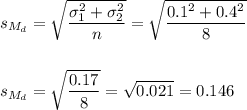
Mathematics, 05.05.2020 18:36, lacyfigueroa
Persons having Raynaud's syndrome are apt to suffer a sudden impairment of blood circulation in fingers and toes. In an experiment to study the extent of this impairment, each subject immersed a forefinger in water and the resulting heat output (cal/cm2/min) was measured. For m = 8 subjects with the syndrome, the average heat output was x = 0.64, and for n = 8 nonsufferers, the average output was 2.09. Let ?1 and ?2 denote the true average heat outputs for the sufferers and nonsufferers, respectively. Assume that the two distributions of heat output are normal with ?1 = 0.1 and ?2 = 0.4.

Answers: 1
Other questions on the subject: Mathematics


Mathematics, 21.06.2019 17:30, scoutbuffy2512
How do you use the elimination method for this question? explain, because i really want to understand!
Answers: 1


Mathematics, 21.06.2019 22:30, cordobamariana07
The difference of three and the reciprocal of a number is equal to the quotient of 20 and the number. find the number.
Answers: 2
Do you know the correct answer?
Persons having Raynaud's syndrome are apt to suffer a sudden impairment of blood circulation in fing...
Questions in other subjects:

Mathematics, 17.11.2021 15:50


English, 17.11.2021 15:50

History, 17.11.2021 16:00

















